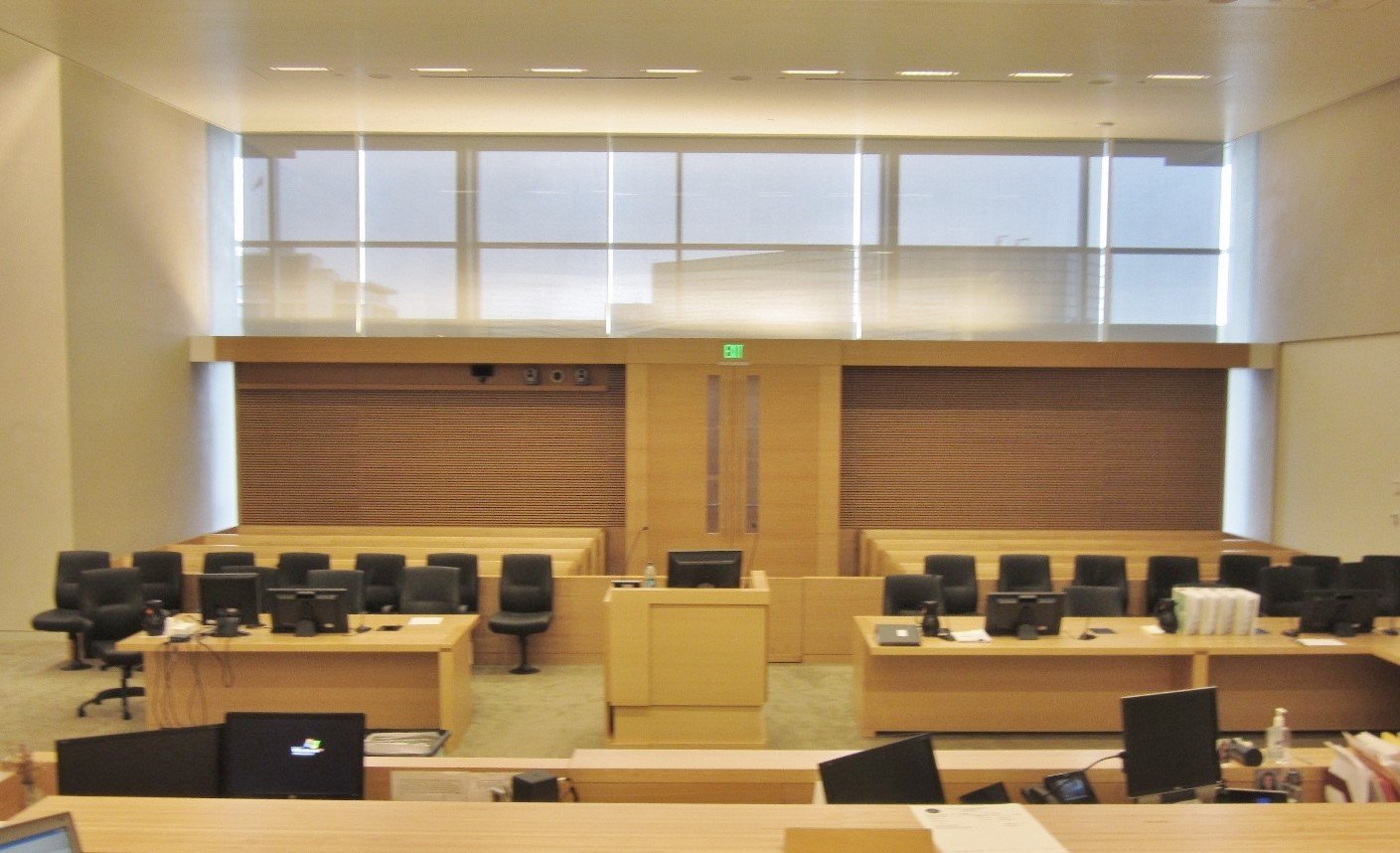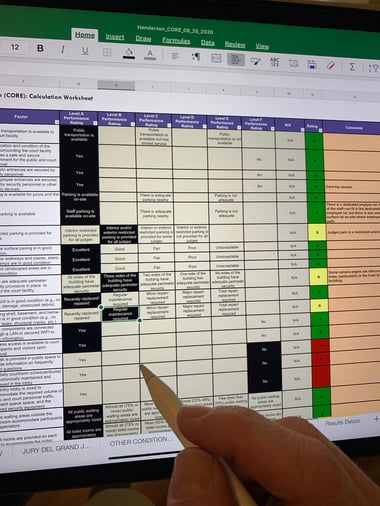

Planning a new courthouse, or a major renovation project for an existing courthouse, is a lengthy and complicated effort that can take many years. A needs assessment is the first phase of such an endeavour. It includes assessing the current and future space needs of the court components and related agencies, evaluating existing facilities, implementing best practices in courthouse design, and identifying potential projects to improve operations. A needs assessment provides the planning team with a valuable set of information to help them select the most viable strategy to meet the court’s current and projected space needs and justify subsequent funding and design decisions.

An effective courthouse needs assessment is described in the following six steps:
1. Assemble Court Planning Team and Set Project Goals. Assemble a court planning team with representatives from all court components and related agencies to provide expertise on workload and resource requirements and to help set goals for the assessment project.
2. Analyze Workload and Produce Staffing Requirements. Gather data and anecdotal input from the planning team on past and current workload and staffing, as well as any trends or initiatives likely to impact workload or staffing in the future. Based on this analysis, produce workload and staffing projections for up to 30 years in the future. This analysis helps provide a solid foundation for space programming, design decisions, and funding approvals.
3. Assess Existing Courthouse. Conduct a comprehensive assessment of the existing courthouse to determine the extent to which the facility meets the current needs of the court and related agencies. At Fentress, we utilize our Courthouse Operations Realtime Evaluation (CORE) tool to assess the courthouse and to identify deficiencies. CORE is comprised of an extensive set of objective performance metrics in the areas of:
4. Develop Program of Requirements. Based on the results of the analysis in Step 2 and the assessment in Step 3, develop a Program of Requirements (POR), an itemized listing of the spaces required to meet the needs of the court components and related agencies today and in the future. The POR includes the quantity and size of spaces, along with circulation and adjacency considerations.
5. Identify Potential Improvement Strategies. Identify potential strategies to address both current and future space needs in the courthouse. Improvement strategies could include renovation within the existing courthouse, an addition to the existing courthouse, construction of a new courthouse, or a combination of these solutions.
6. Conduct Gap Analysis to Determine the Most Viable Strategy. Conduct a gap analysis to objectively evaluate the benefit of each of the improvement strategies. A gap analysis:

At the outset of any court planning project, a planning team comprised of key stakeholders should be assembled. Representatives from all court components and related agencies that occupy space in the courthouse, or that have a direct or indirect stake in the courthouse project, should be included on the planning team. When performing a needs assessment for a criminal court, here is an example of the components that should be included:
The stakeholders’ firsthand knowledge of the court's organization, operations, and workload drivers is key to developing a valid needs assessment. The more engaged the stakeholders are in the process, the more the design will reflect the functional needs of the entire court family. Additionally, this engagement increases stakeholder buy-in and helps limit the number of costly changes needed during the design and construction phases. A collaborative needs assessment with the input of all stakeholders pays for itself many times over.
It's important for the court planning team to meet in the early stages to develop a shared vision for the future of the court. This vision is critical to developing key assumptions that will guide the courthouse planning effort, as well as the future design of any project intended to meet the court's needs. The court planning team should also work collaboratively to establish the project goals. Examples of project goals include increasing security, consolidating groups that are currently fragmented, incorporating modern technology into the courthouse design, or developing a design that is reflective of the local community and culture.


The courthouse needs assessment process involves a detailed evaluation of the historical, current, and projected volume of caseload processed through a courthouse, which in turn drives the need for judgeships, personnel, court operations, and space. By discussing workload and staffing trends and developing projections of future staffing and space needs, the court planning team gains a much clearer understanding of the demands placed on the courthouse and the need for additional, or reconfigured, space.
It is critical to consider each of the following factors when performing courthouse demand planning, as each of these may have an impact on court workload.
The key is to generate realistic assumptions about how the trends may impact current and future court operations and workload. Statistical methods, such as time series analysis, are used to produce projections of future workload, which help determine projected staffing and space requirements. It is important to blend quantitative data and analysis with the qualitative insights gleaned from members of the court planning team.
The process of planning, funding, designing, and constructing a major courthouse project can take ten years or more. Further, upon occupancy, there should be capacity for the court to grow in the space for an additional five to ten years without having to acquire additional space. For these reasons, workload and staffing forecasts 20 to 30 years into the future are recommended.
One disadvantage of a long-term forecast is that the further out the forecast extends, the less statistically reliable the result. Although the forecasts are a necessary part of the planning process, there is no fail-safe way to predict the many factors that can impact court trends over an extended time period, including:
Thus, the challenge is to predict reasonable long-term trends. The reasonableness of longer-term forecasts can be evaluated in part by benchmarking the planning results of a particular court against other jurisdictions of similar size and complexity. For example, when planning for a county court, it is helpful to look at other counties regionally that share similar trends. Such trends would include geography, population, economic indicators, workload, the number of judges, and the number of court personnel.
Statistical methods such as cluster analysis can be used to group courts with similar trends. These groups, or “growth models,” can be used to help the court planning team assess how the workload and staffing projections compare to those of similar court jurisdictions.

Concurrent with the workload analysis, an assessment of the existing courthouse and each component’s space should be conducted. At Fentress, we conduct our assessments using our unique Courthouse Operations Realtime Evaluation (CORE) tool, which contains a library of over 500 courthouse performance factors and accompanying metrics. We apply a subset of these factors, as applicable, to each courthouse assessment project.
Utilizing performance metrics helps identify deficiencies within the existing facility. The CORE tool is designed to focus on the following criteria:The performance metrics are applied to all spaces (courtrooms, chambers, office spaces, public spaces, and secure spaces) within the courthouse. We typically use between 200 and 300 factors to assess a courthouse.
The result of the CORE assessment is a score between 0 and 100, with a score of 100 representing an ideal courthouse. These baseline results are very important during the planning and programming process. They can be used to determine the magnitude of the deficiencies, to measure the relative benefits of implementing potential improvement strategies, and to provide an objective measure for prioritizing project phasing and funding.
After validating the workload analysis and assessing the existing courthouse, the next step is to interview each of the stakeholder groups that will be housed in the courthouse to develop a Program of Requirements (POR) to meet projected space needs.
The POR should detail the current space occupied by each component and the future space needed over the planning period (20 or more years). The POR provides requirements for individual space types, such as courtroom sets, chambers, courthouse security and prisoner holding (if applicable), office space, shared spaces, and other general areas of the courthouse. It also includes a detailed list of spaces within each component, the usable square footage of each space, an overall departmental gross square footage, and any comments or assumptions that support the programming effort. An overall building gross square footage can then be generated by applying industry standard multiplying factors for building support (MEP, building storage, etc.) and circulation factors to the POR.
During the stakeholder interviews, issues that could impact the POR should be discussed. In particular, space-saving methodologies that have proven to be successful in other courthouses should be considered.
Some of the operational changes and space reduction initiatives that the Fentress team has identified through our courthouse planning efforts include:


The information from the workload analysis, CORE tool assessment, and POR is then used to develop potential improvement strategies for presentation to the courthouse planning team. An improvement strategy is a project - or sequence of projects - and operational changes aimed at optimizing the space in the courthouse. Improvement strategies address as many space needs and functional deficiencies identified by the CORE tool as possible, and accommodate current and future staff as determined by the POR.
Improvement strategies include the following types of projects:
Project feasibility is an important aspect that needs to be considered. Identifying feasible alternatives for addressing both current and future space and adjacency needs in the courthouse is based on the following criteria and considerations:
As an example of how this process might be applied, consider a courthouse that currently has courtrooms and chambers for four judges but requires two additional courtrooms and chambers in the future. If there is available space in the courthouse to build out the additional facilities for the judges in a manner that would meet space and functionality standards, a renovation alternative could be considered. Should the available space also be needed to accommodate other needs - perhaps an expansion of the clerk’s office and improved secure circulation patterns - constructing an annex on an adjacent property to house the additional judges could be a second alternative to consider. Should the dimensions of the adjacent property be less than ideal for accommodating standard-sized courtrooms and chambers, clerk’s office expansion, and secured circulation, an entirely new courthouse could be a third alternative to study.
This planning process not only applies to the courtrooms and chambers, but to all of the court and related component functions and offices, as well as to security and circulation considerations. Once feasible improvement strategies have been identified, schematic floor plans are created to help visualize how the strategies will meet the identified needs, as shown in the example below:

 The benefit of each potential improvement strategy can be analyzed to determine the alternative that best addresses the needs and deficiencies identified by the POR and CORE tool. Each improvement strategy is scored, and the results are compared to both the building baseline score and the ideal courthouse score (100) to determine the extent to which each improvement strategy "closes the gap" between the existing and ideal state. This is commonly referred to as a gap analysis.
The benefit of each potential improvement strategy can be analyzed to determine the alternative that best addresses the needs and deficiencies identified by the POR and CORE tool. Each improvement strategy is scored, and the results are compared to both the building baseline score and the ideal courthouse score (100) to determine the extent to which each improvement strategy "closes the gap" between the existing and ideal state. This is commonly referred to as a gap analysis.
For example, if a courthouse scores 60 out of 100 using the performance metrics, a renovation project to add a new courtroom could potentially increase the score of the courthouse to 70 points. Perhaps an annex could increase the score to 85 points, while a new courthouse could increase the score to 100 points if designed correctly. The use of performance metrics allows the effectiveness of each improvement strategy to be objectively measured and compared with other alternatives. The figure below displays how a gap analysis is used to quantify the benefit of each improvement strategy.
Rough order of magnitude costs are developed for each improvement strategy, which are then used to perform a cost-effectiveness analysis. The cost-effectiveness analysis determines not only the strategy that yields the greatest benefit, but also the greatest benefit relative to cost.
Another factor that must be considered is how well each strategy’s implementation timing corresponds to the timeline of projected space needs, as well as the risk of having a less than fully functional court before a strategy can be fully implemented. Each improvement strategy's costs (rough order of magnitude), implementation timing, and risks should be discussed with the stakeholders to gather detailed feedback and suggested revisions. After these discussions, the recommendation(s) deemed most viable is identified as the recommended strategy.

Analyze Your Current Website Setup
Before you begin, you need to know basic information about your website. Here are the things you need to look for when analyzing your setup:
If either of these issues exists, it is imperative that they are taken care of before the optimization stage. If your website is poor, out-of-date, or not user-friendly, an SEO campaign is going to have a very little effect. You need much more than just a good keyword and optimization strategy to succeed.
Topic Creation & Keyword Research
As stated earlier, it is very important that we are optimizing around topics rather than keywords. However, we still need to do some keyword research to see what types of keywords within that particular topic we want to optimize for as well.
First things first, we need to come up with the topics we want to focus on for the campaign. We do this during a brainstorming session. Write down as many topics as you can think of. A topic is usually just one or two words long, such as “Digital Marketing” or “About Us.” Ask yourself the following to get you started:
Once you have brainstormed the list, try to narrow it down as much as possible. Combine duplicates, remove any that are irrelevant/not necessary, only choose what you feel is most important. Keep in mind that you can always revisit this later down the road.
After the topics have been decided, it is time to do some research into what you want to optimize your website around. We use SEMRush for this, but there are plenty of other tools, like Moz or Rank Tracker.

